
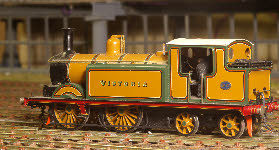


Updated August 2016
E3 no 165 ex ‘Blatchington’
E4 no 566 ex ‘Durrington’
E4 no 468 ‘Midhurst’
E4X no 478 ex ‘Newick’
E5 no 584 ‘Lordington’
E6 no 410 ‘Chilgrove’
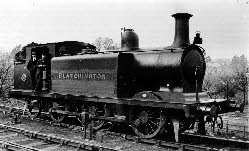 Following William Stroudley’s experiments with modifications to his 0-
Following William Stroudley’s experiments with modifications to his 0-6-0 tanks in the form of his E1R ‘West Brighton’, his successor Robert Billinton developed a series of 0-6-2 tanks, starting with the goods E3’s. He followed this with the E4 mixed traffic (5ft wheels), E5 passenger tanks (5ft 6” wheels), and finally E6 heavy goods (4ft 6” wheels). Many of the E4, E5 and E6 classes were reboilered with I1 or I2 boilers. Those with the larger I2 boiler had the suffix ‘X’ added as in ‘E4X’.
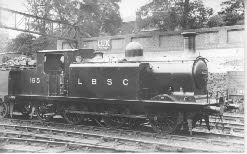 Blatchington was the first of the ‘small radials’ (E3) to be completed (1894), and the last to be withdrawn (1959) -
Blatchington was the first of the ‘small radials’ (E3) to be completed (1894), and the last to be withdrawn (1959) - after almost 65 years in service.
The photo on the left shows the loco in original (but rather tired) livery - Stroudley’s goods green with the name on the side tanks. The photo on the right shows it in Billinton’s lined black livery, lettered LBSC, and with a later boiler - large dome, and safety valves mounted in front of the cab, rather than on the dome. My model is of the loco with its original boiler, and the intermediate lined black livery, lettered LB&SCR.
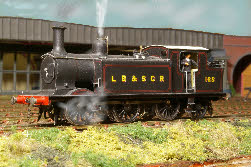
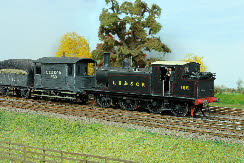 This is the first loco I finished, and has undergone a number of rebuilds. It's fully compensated, but started as a rigid 0-
This is the first loco I finished, and has undergone a number of rebuilds. It's fully compensated, but started as a rigid 0-8-0 style chassis (ie without a pony truck for the trailing wheels). This didn't work so I copied the prototype, and assembled a radial axle box out of sheet metal - which worked. I think this was one of the earliest 4mm models to use a radial axlebox - it certainly earned a few compliments when first made in 1981.
Since then, Blatchington has been converted to split axle pick-up (in common with all other locos I have made) which necessitated a new radial box, made out of perspex - a complete ring turned on a lathe, and then cut into suitable lengths. My model is now over 35 years old, and has received three new motors (culminating in the Portescap seen here), but has not undergone any other major work until recently. However, the hornguides have now finally worn out, such that the axle bearings can move fore-and-aft by something approaching 0.5mm. The result is an ugly waddle along the tracks. The chassis has therefore been stripped down, old hornguides and bearings removed, new ones made and everything put back together - about a day’s work. The result is a much improved engine.
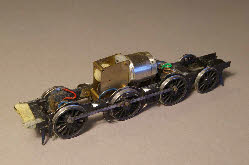 An overall view of the chassis, showing the basic layout -
An overall view of the chassis, showing the basic layout - Portescap driving on the centre axle (via modified MJT gearbox), sidebeam compensation for the front two axles, and centre beam compensation for the rear driver and radial axle box. The radial axle box is just about visible.
The frame spacers are copper-clad paxolin, gapped in two places to insulate the frames from each other. The coupling rods are milled from steel, and are jointed in front of the centre axle. Electrical pick up is from the six driving wheels.
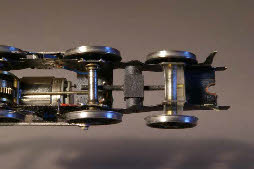 A view from the underside of the trailing axle. The centre compensation beam is mounted through a perspex block which pivots in the side frames. The beam bears directly on top of the radial axle box, and the rear driven axle. The clear perspex radial axle box is rather difficult to photograph well.
A view from the underside of the trailing axle. The centre compensation beam is mounted through a perspex block which pivots in the side frames. The beam bears directly on top of the radial axle box, and the rear driven axle. The clear perspex radial axle box is rather difficult to photograph well.
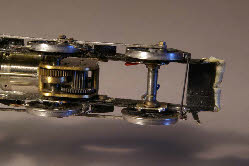 This is the front of the chassis, showing the gearbox, sidebeams, and split axles. The front axle is in two parts (the white spacer can be seen) whereas the centre driven axle is in three parts -
This is the front of the chassis, showing the gearbox, sidebeams, and split axles. The front axle is in two parts (the white spacer can be seen) whereas the centre driven axle is in three parts - the centre part is slightly wider than the gearbox.
There is no sideplay in the leading or third axle. There is as much sideplay as possible in the second axle, and the gearbox assembly can move sideways along the axle, allowing the axle itself to move side-to-side to accommodate curves and turnouts.
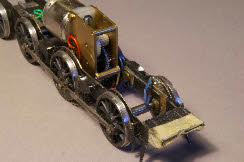 The front again, showing the sidebeams resting on the axle bearings, the pickup wires are soldered direct from the bearings to the main frames.
The front again, showing the sidebeams resting on the axle bearings, the pickup wires are soldered direct from the bearings to the main frames.
The tape over the front end of the chassis is a very unsophisticated way of insulating the chassis from the body - essential for split frame locos.
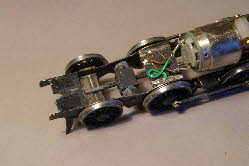 The rear of the chassis -
The rear of the chassis - axle box and centre compensation beam in view.
E3 no 165 ex ‘Blatchington’
E4 no 566 ex ‘Durrington’
E4 no 468 ‘Midhurst’
E4X no 478 ex ‘Newick’
E5 no 584 ‘Lordington’
E6 no 410 ‘Chilgrove’
 Following William Stroudley’s experiments with modifications to his 0-
Following William Stroudley’s experiments with modifications to his 0- Blatchington was the first of the ‘small radials’ (E3) to be completed (1894), and the last to be withdrawn (1959) -
Blatchington was the first of the ‘small radials’ (E3) to be completed (1894), and the last to be withdrawn (1959) -The photo on the left shows the loco in original (but rather tired) livery -

 This is the first loco I finished, and has undergone a number of rebuilds. It's fully compensated, but started as a rigid 0-
This is the first loco I finished, and has undergone a number of rebuilds. It's fully compensated, but started as a rigid 0-Since then, Blatchington has been converted to split axle pick-
 An overall view of the chassis, showing the basic layout -
An overall view of the chassis, showing the basic layout -The frame spacers are copper-
 A view from the underside of the trailing axle. The centre compensation beam is mounted through a perspex block which pivots in the side frames. The beam bears directly on top of the radial axle box, and the rear driven axle. The clear perspex radial axle box is rather difficult to photograph well.
A view from the underside of the trailing axle. The centre compensation beam is mounted through a perspex block which pivots in the side frames. The beam bears directly on top of the radial axle box, and the rear driven axle. The clear perspex radial axle box is rather difficult to photograph well.  This is the front of the chassis, showing the gearbox, sidebeams, and split axles. The front axle is in two parts (the white spacer can be seen) whereas the centre driven axle is in three parts -
This is the front of the chassis, showing the gearbox, sidebeams, and split axles. The front axle is in two parts (the white spacer can be seen) whereas the centre driven axle is in three parts -There is no sideplay in the leading or third axle. There is as much sideplay as possible in the second axle, and the gearbox assembly can move sideways along the axle, allowing the axle itself to move side-
 The front again, showing the sidebeams resting on the axle bearings, the pickup wires are soldered direct from the bearings to the main frames.
The front again, showing the sidebeams resting on the axle bearings, the pickup wires are soldered direct from the bearings to the main frames.The tape over the front end of the chassis is a very unsophisticated way of insulating the chassis from the body -
 The rear of the chassis -
The rear of the chassis -